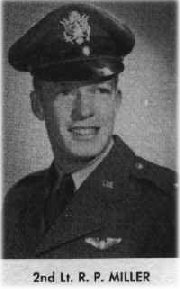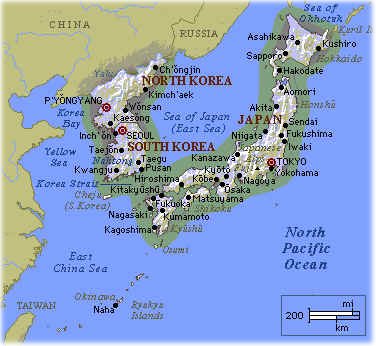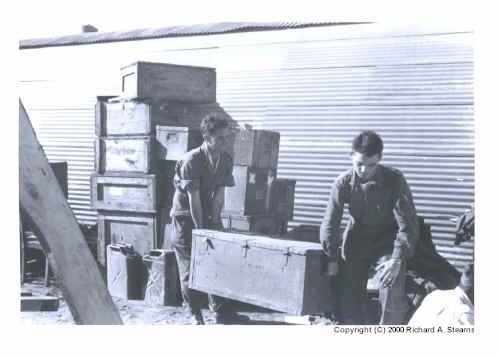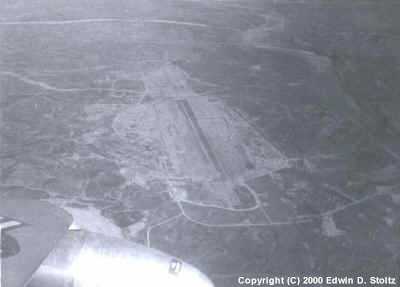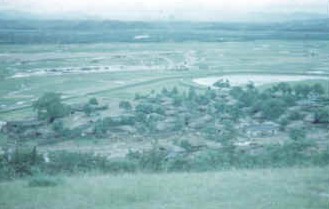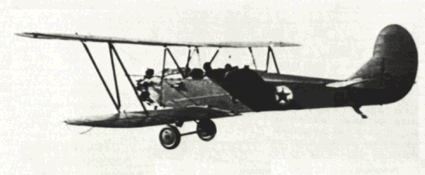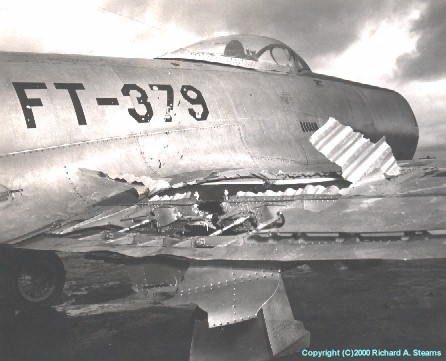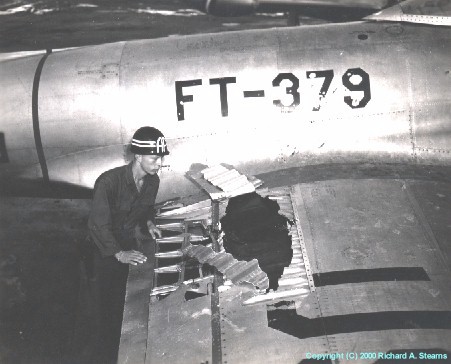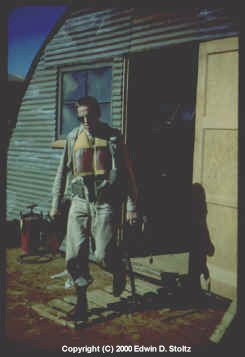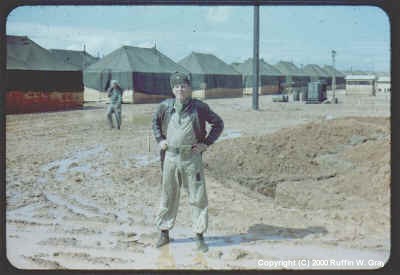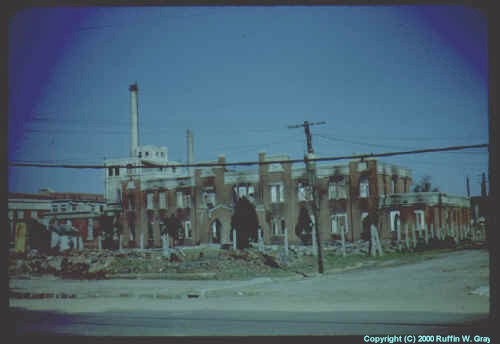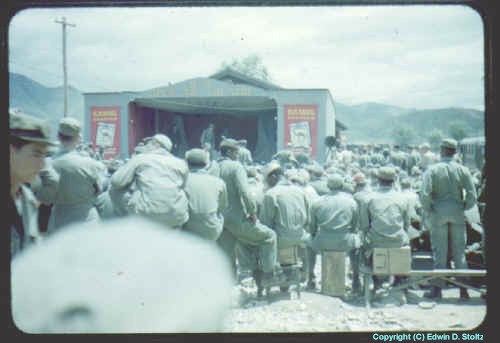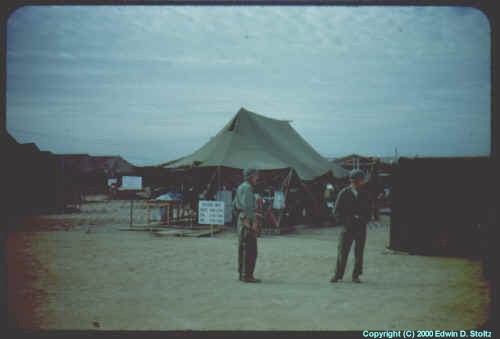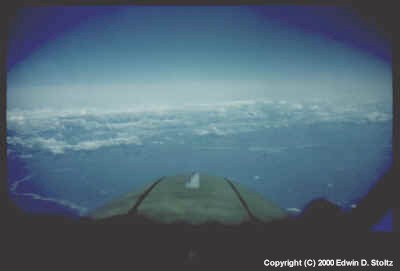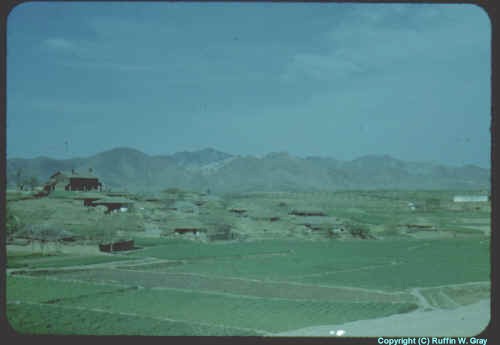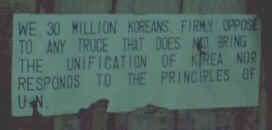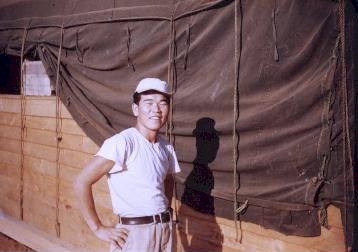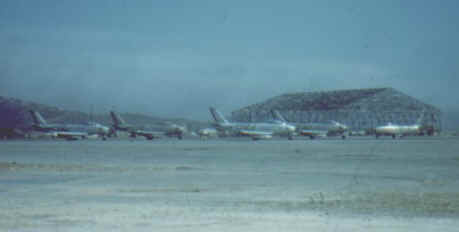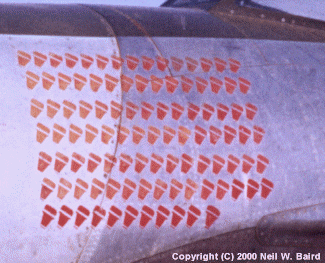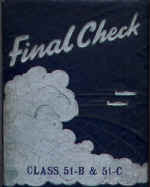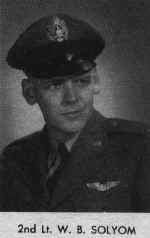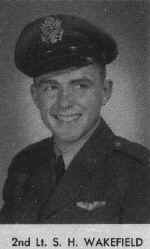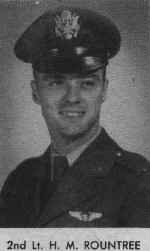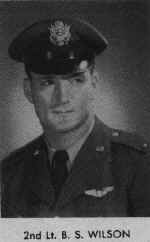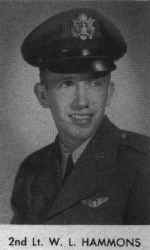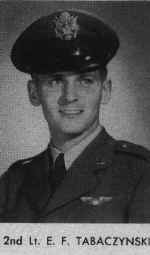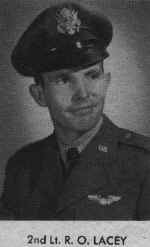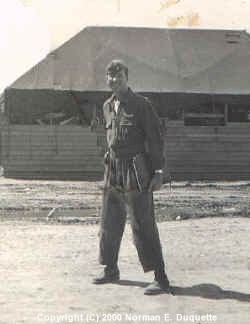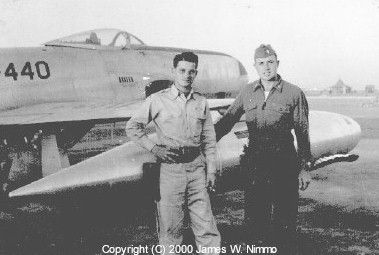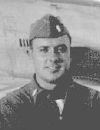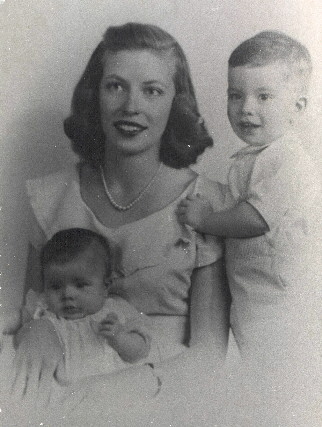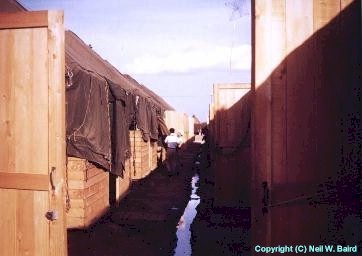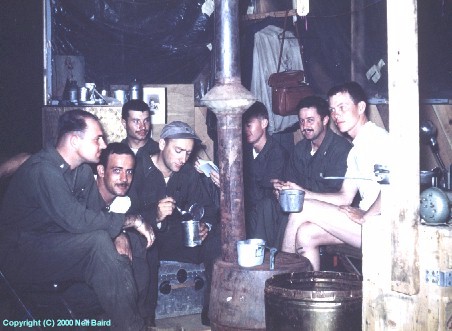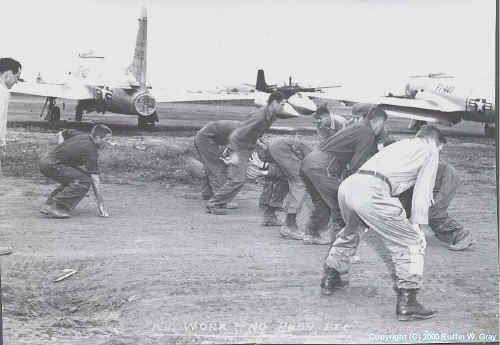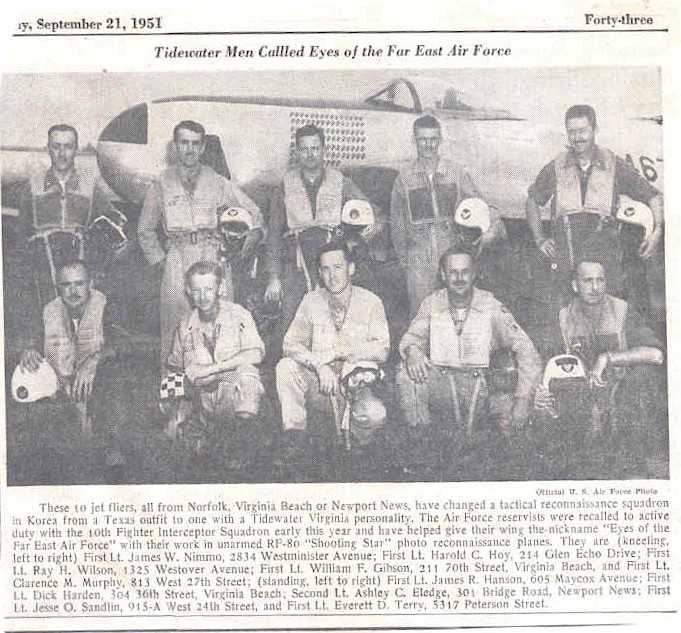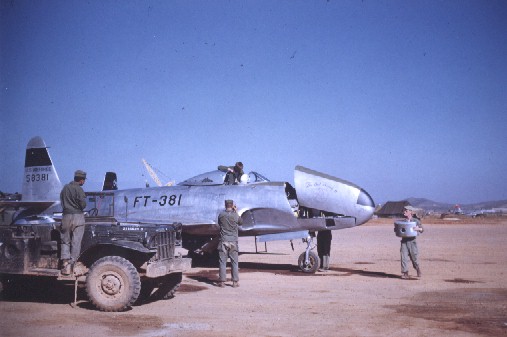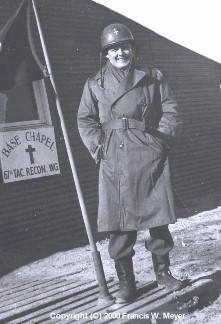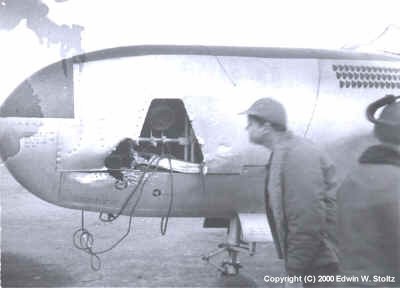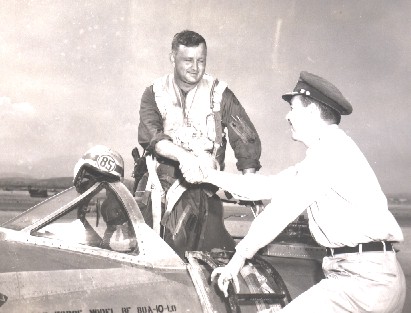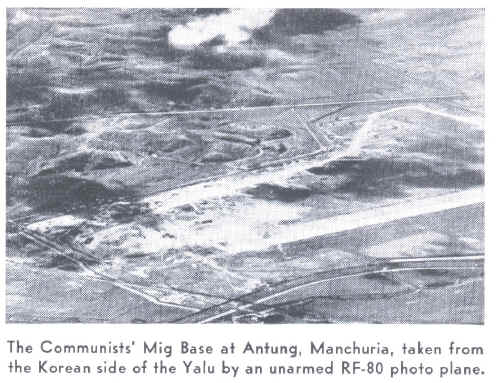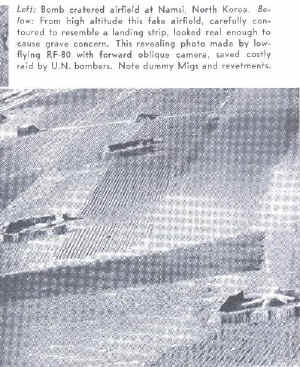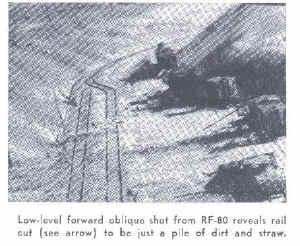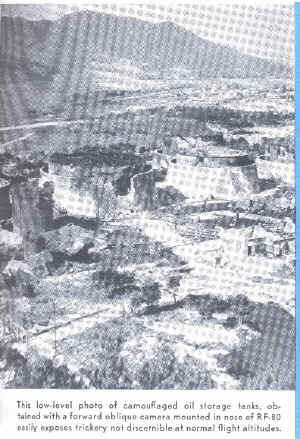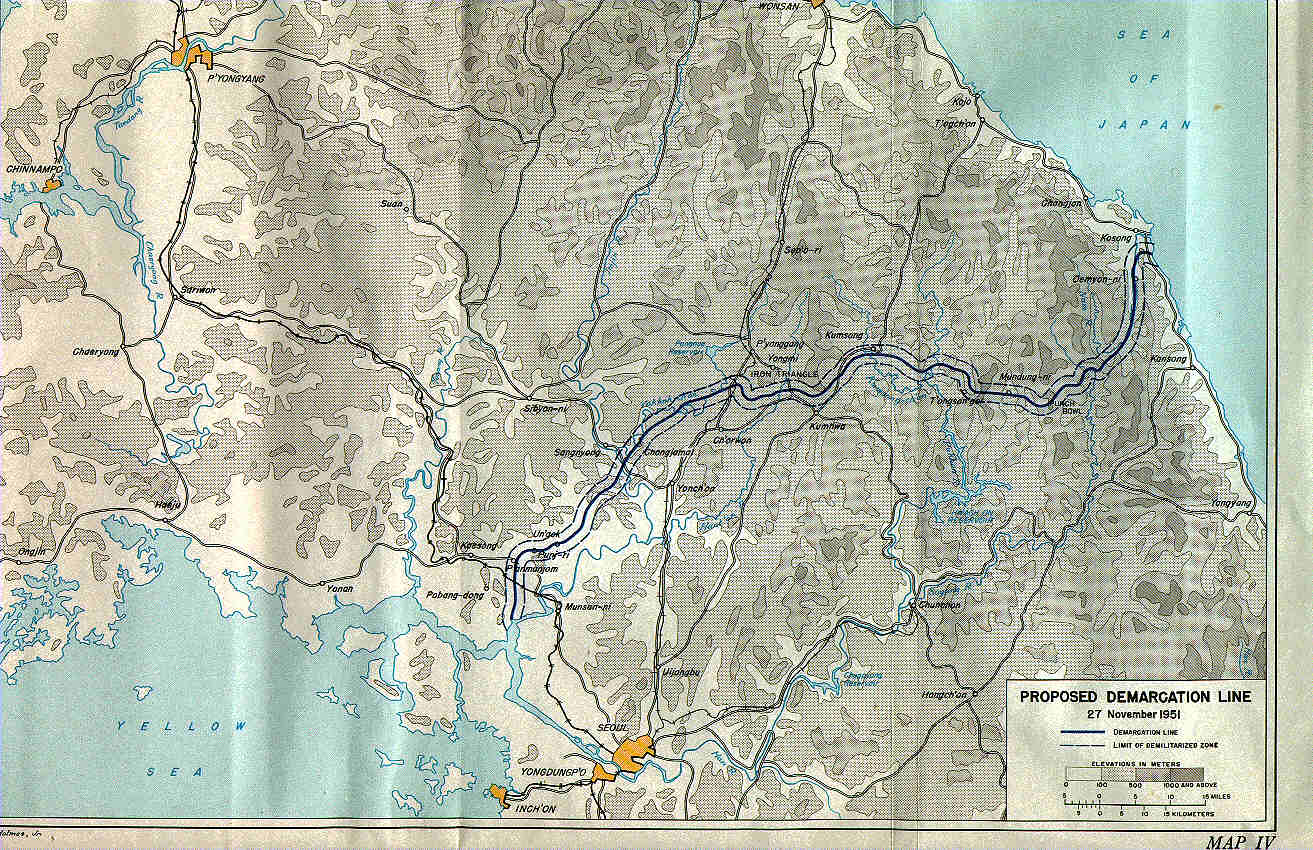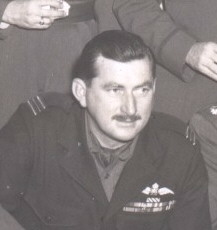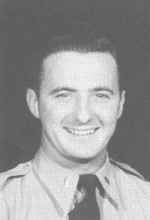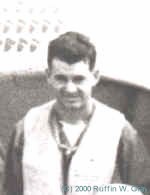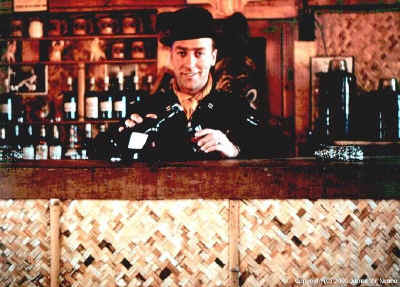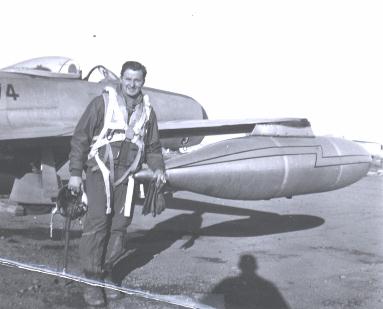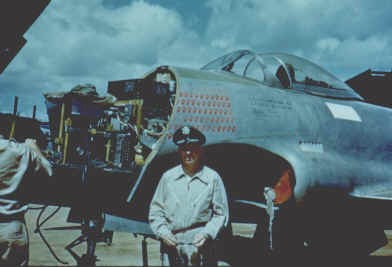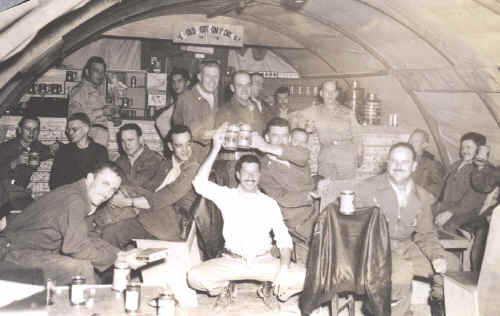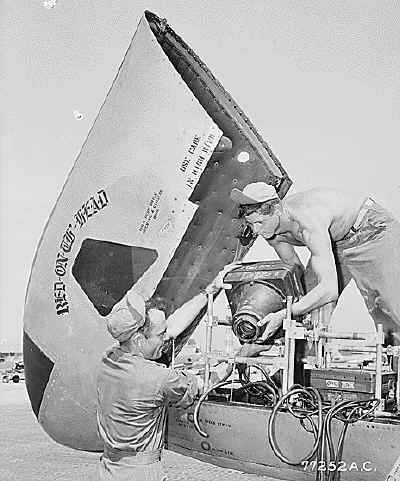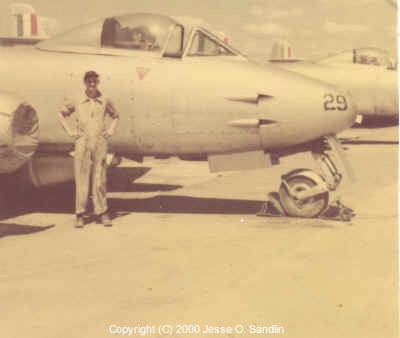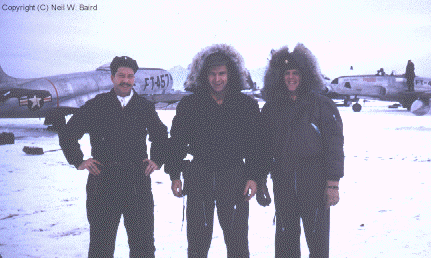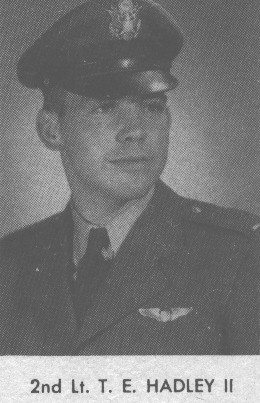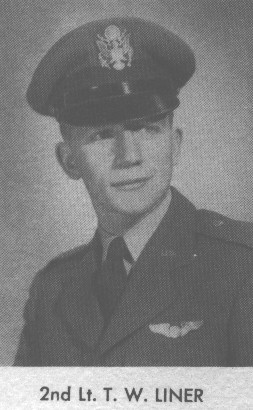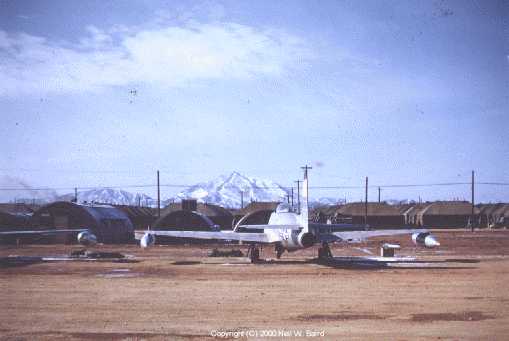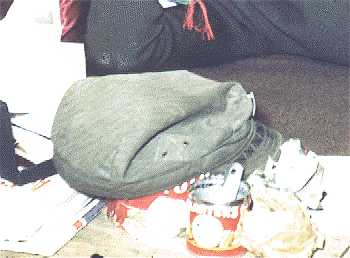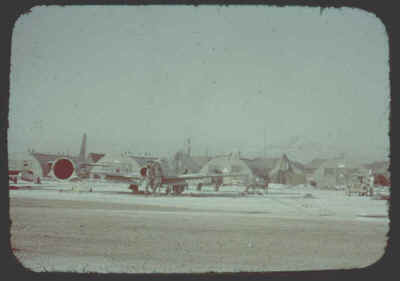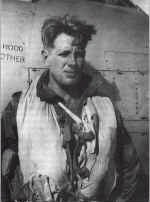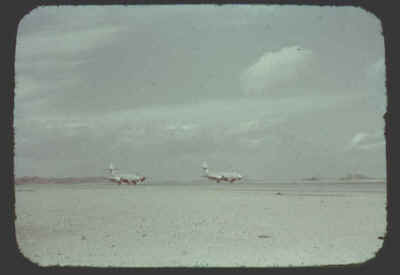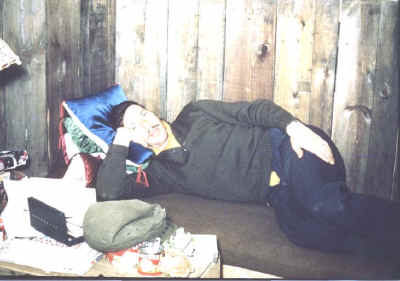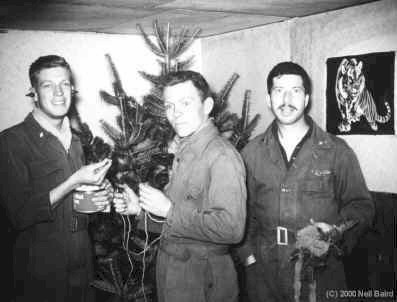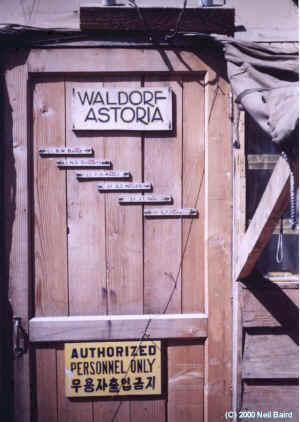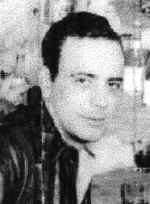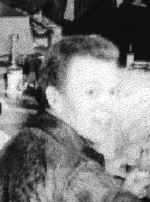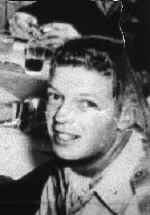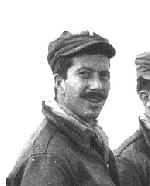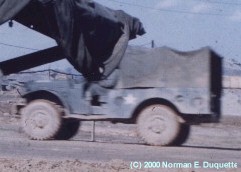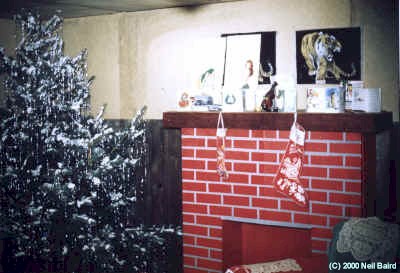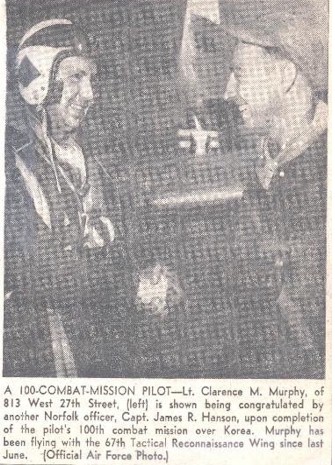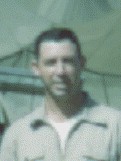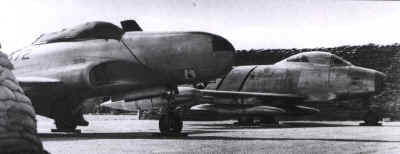
RF-80A & RF-86 in
revetment at Kimpo, 1952
CODE NAME: HONEYBUCKET
by Ruffin W. Gray
Colonel, USAF (Ret)
Commander, 15th TRS -- Oct. '51 - May '52
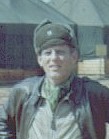
In the fall of 1951,
the MiGs had become very aggressive and were eating our lunch. They
would over fly formations of F-86s, F-84s and F-80s to get to a
single RF-80 with its easily spotted distinctive nose. The MiGs
could outrun, out dive, out climb us and had a much higher service
ceiling. Our only advantage was turn radius and maneuverability.
5th AF decreed that an RF could not go north of Pyongyang without
a wingman and not go north of the Chong-Chong River without an F-86
escort.
We were urgently trying
to find a better airplane, and everyone said that it was impractical
to try to convert an F-86 to a camera role. But Joe Daly and I weren't
convinced. We started spending hours on the 4th Fighter Wing side
of the field in the nose of an F-86, and each time there was an
accident, we were there trying to beg for the nose section. We finally
figured out a way to mount a K-20 camera on its side by taking out
the bottom gun and shooting vertical photos through a mirror mounted
at a 45-degree angle. Col. Harry Thyng finally let us have two old
war weary F-86A's and we worked a deal with the depot in Japan to
mount the cameras, mirrors and camera windows.
Joe Daly
flew the first one in from Japan on its first mission. We left them
painted in the exact same markings as the 4th Fighter Wing aircraft;
kept them parked with the other F-86's and used them flying lead on
one of the 4th Wing fighter sweeps so that the flight just happened
to overtly the areas we needed to photograph. As soon as we began
flying them, the experts from the states who had said it couldn't
be done began coming out with all kinds of improvements. We had kept
this all hush, hush under the code name "Honeybucket". We
later had a flight of RF-86's and I believe that the squadron eventually
was equipped with nothing but RF-86's that ultimately went to the
ROKAF.
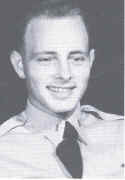
1Lt. Jim Fosdick
Lt. Jim
"Fearless" Fosdick flew an RF-86 on a low level mission
in MiG alley and picked up a lot of ground fire and aircraft strikes
including a slug that came into the right console and knocked out
the radio. When the slug came through, it hit a parachute harness
buckle on Jim's hip; the slug split in half and halt went into the
instrument panel. The other half hit Jim in the side; hit a rib and
slid around to his back. Jim flew back; landed and taxied in; made
out the form 5; came down the ladder; pulled back the side of his
backpack and asked the crew chief it he was bleeding back there. When
the crew chief acknowledged that he was, Jim calmly asked that he
call an ambulance since he had been shot.
KOREA
15th Tactical Reconnaissance Squadron, Kimpo.
(an extract, "From Kid to Captain" by James R. Hanson)
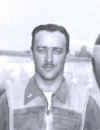
"I
come up with another idea which improves squadron morale and shows
up in work accomplished. Until now everybody in the squadron worked
7 days a week and as many hours a day as it took to get the job done.
The airmen have to work three months without a break before getting
five days leave in Japan. Pilots get three days R and R in Tokyo every
six weeks. I asked the C.O. to let each airman have half a day off
once a week in which they can sleep in or visit other squadrons on
the base. We can't leave the base because of snipers etc., but it
will give them some free time. As far as the pilots, I brief them
before dawn and pass out missions to each flight leader to assign
to their flight members. Now we'll rotate flights, one flight will
get to sleep in each morning until 10, and then I'll give them the
same briefing as the others. It'll mean an extra briefing for me or
my assistant but everyone likes the idea. This also becomes SOP (standard
operating procedure)."
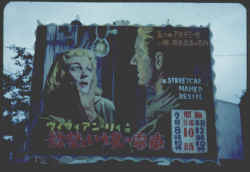 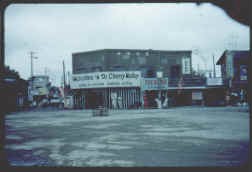
Letter:
2Lt. Norman E. Duquette
From Japan
8 Oct 51

Dearest Louise Jay &
Jan --
I'm on my R&R now.
I'm in a rest hotel called the "Prince Shimazu". It's
a pretty nice place. Miller & I & a Catholic Chaplain are
in the same room. They have just about everything here for relaxation.
Fine beds, a barber shop where I get shaved in the morning, a P.X.,
a bar & lounge, spacious green lawns surrounding the place,
play rooms, reading rooms, a 24-hour laundry and cleaning service,
& above all excellent food. I got here Friday night. Friday
night I had steak for supper, Saturday morning I had pancakes, at
noon I had 1 Fillet Mignon, for supper I had 2 Fillet Mignons, yesterday
morning I had eggs & bacon, orange juice, coffee, toast. For
dinner I had 3 pork chops & accessories, for supper T-bone steak.
I got Jay & Jan some
cute little jackets. Sort of a birthday present for Jay. Toys are
scarce here so I thought that you could get him a toy for me. I
wish you would take some pictures of the kids with [the] jackets
on. I think they should just about fit.
Have you
received my uniforms yet? I had them insured just in case. I want
to call you some time today. I hope it doesn't worry you by getting
a call from Japan.
I got my 18th mission
in just before I left Korea. Almost 1/5 of my tour complete. I'm
four missions ahead of Miller. He was grounded a few days with a
cold. He bought Anne a ring here at the P.X. yesterday.
I want to get my X-Mas
shopping done today. I had my picture taken yesterday. Should get
them in a couple weeks.
I'm going to place that
call now so will talk to you in a few hours.
Love you & miss you.
Duke
Letter:
2Lt. Norman E. Duquette
Kimpo Airfield, Republic of Korea
11 Oct 51

Dearest Louise, Jay &
Jan --.
I got back
from R&R today. Had a letter from you waiting for me. We had a
fine time. The thing I enjoyed most was the uninterrupted sleep at
nite. No crawling into a foxhole at 2 A.M. I indulged in two or three
good hot showers a day. Plus three meals a day of delicious choice
foods on white tablecloths. I'd get up in the morning & run downstairs
to the barber shop in pajamas & slippers for a shave (.15c). We
ran into a couple of 51-B men and had quite a party one night. Found
out that Grammar from 51-B was shot down last week.
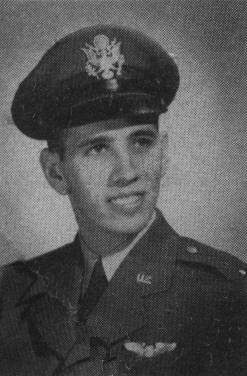
2nd Lieutenant Wilbert W. Grammer
I decided against calling
you as I was afraid you'd be quite worried before you got to the
phone. I'll call next time so you can expect it now.
I bought some new underwear,
shirts & shorts, 6 pair, some socks (black & wool) 6 pair;
a new pair of pajamas (they're yellow with a yellow plaid collar
& cuffs) I got some new sock slippers; a camera & 18 rolls
of film. I had some pictures made. I got a new silk scarf white
with squadron insignia of tiger on it. I got some pocket books,
flashlight batteries, bulbs & phonograph records. I got a set
of Symphony No. 4 in E Minor & a set of H.M.S. Pinafore.
Well back on the job
again tomorrow. It took us from midnight till 8:00 A.M. to get back
here from Tokyo by C-54. So I am rather beat out tonight. I'm going
to bed early so will get this in the mail & write again tomorrow.
Love you & miss you.
Duke
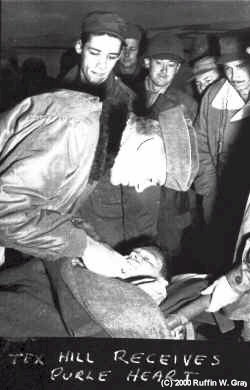
Tex Hill Gets a
Purple Heart
by
Norman E. Duquette
Lieutenant Colonel, USAF (Ret)
Tex Hill was wounded
in the Fall of 51. I had the duty on "Mobile Control"
(a small radio shack which would be stuck onto/along side the landing
end of the runway, manned by a duty Pilot, equipped with two way
radio gear, binoculars, and flare gun with red and green flares).
The duty of the Mobile Control Officer was to visually check that
landing gears were fully extended for landing, and to be an extra
pair of eyes to assist the tower operator with operational or mechanical
aircraft difficulties/decisions.
Tex had received flak
damage to his aircraft and wounds in his leg and was bleeding pretty
badly for some time enrobe back to Kimpo from the far North. He
radioed in regarding his difficulties. Tex was able to remove his
belt and apply it to his leg to put pressure to control the bleeding.
By the time he reached the Kimpo area his leg was numb and was of
no assistance to him for controlling the aircraft for landing, nor
the brakes after landing.
He was
told to make a straight in approach to Kimpo as soon as he had sighted
the field. I monitored extensions of his landing gear, speed brakes
and flaps, and his approach altitudes, aircraft attitudes and air
speeds, and was in general "the friendly voice" of assistance.
Tex made the landing, a little fast in air speed, but otherwise a
good landing. At my suggestion, Tex shut down the engine after landing
touchdown to enable the aircraft to come more quickly to a stop without
having the assistance of braking action. The plane came slowly to
a halt in the center of the runway about two thousand feet from the
end. Good job by Tex.
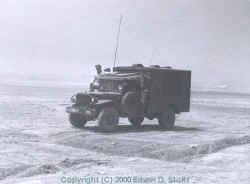
"Meatwagon"
An ambulance at K-2, Early 1951
Ambulance etc. were
immediately on hand to remove him from the plane and take him to
the base hospital tents. His aerial photography films were immediately
removed from the plane and taken to the photo labs for development
and analysis. After initial treatments, he was flown over to Nagoya
Hospital in Japan.
Tex spent many weeks
there in the Nagoya Hospital where he would receive Squadron visitors
who were in Japan for R&R. I visited with Tex on one occasion
at the Nagoya Hospital. That was not Col. Chickering administering
the Purple Heart, it could have been Col. Howard who preceded Chickering
or it could have been someone from 5th AF HQ.
Copyright (C) 2000 Norman
E. Duquette
KORWALD Loss Incident Summary
[ http://www.dtic.mil/dpmo/pmkor/korwald_info_3097.htm ]
Date of Loss: 511108
Tail Number: UNK
Aircraft Type: RF-80A
Wing or Group: 67th Tac Recon Wg
Squadron: 15th Tac Recon Sq
Circumstances of Loss: Damaged by AAA while on low-level photo recon
mission
Crewmembers Associated
With This Loss
Name (Last, First Middle)
/ Rank / Service / Status / Comments
HILL, Dennis W. CAPT USAF
WIA
67th RTS, APO 970, Special
Airfield Rpt. #20 dtd. 1 Nov. 51.
Photo 5 (PRINT 40VV R6186B 15TRS 21 Oct 51)
Eight (8) dummy bomb craters have been spaced along the southern half
of the
taxiway since photography of 21 October.
ATTACHMENTS: Photos 1 -
5
Submitted by: Approved
by:
Benson B. Hardy A.A. Grumbine
2nd Lt. USAF Major, USAF
OIC, PI Department
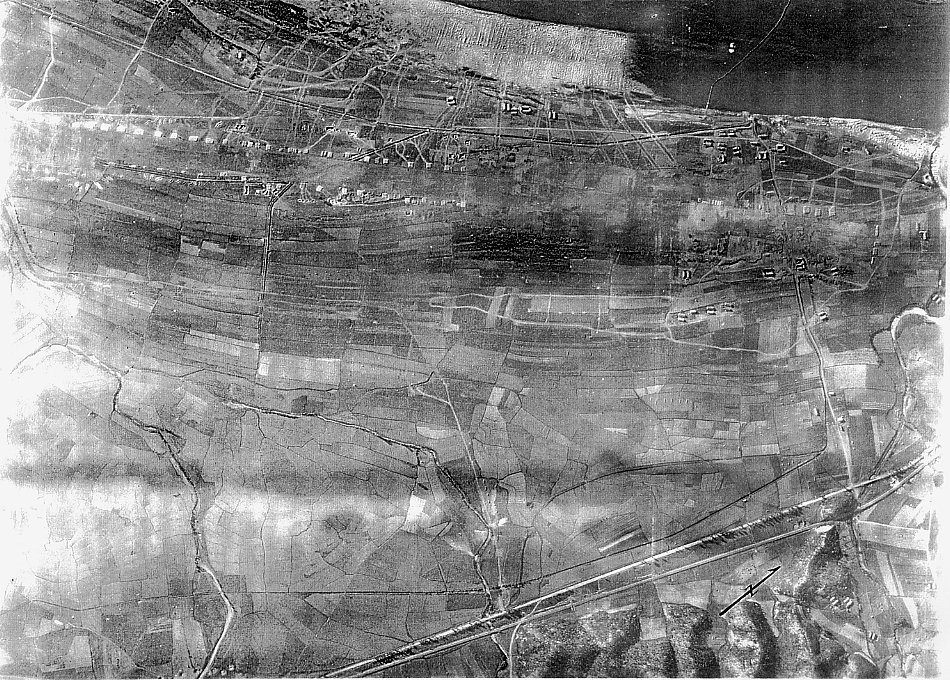
Photo 1
VV52 15h Tac Recon Sq R5624B 25 Sep 51
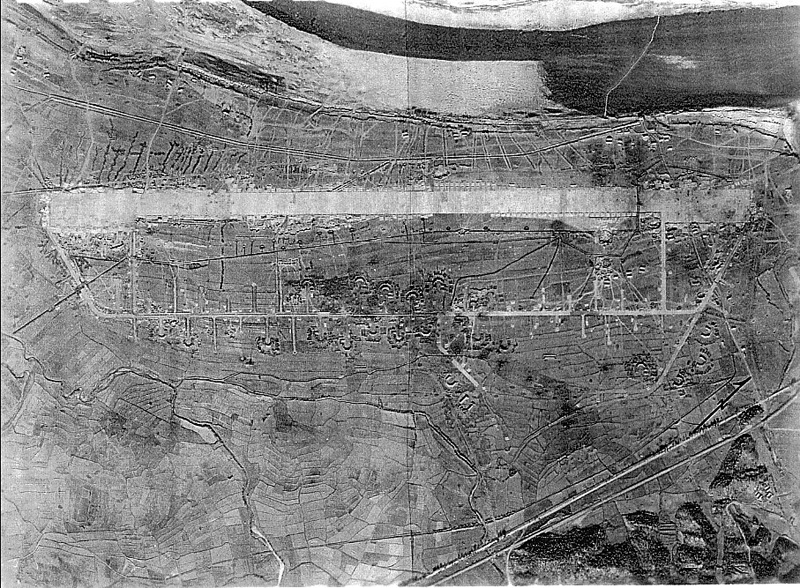
Photo 2
VV22-23 15th Tac Recon Sq R6018B 14 Oct 51
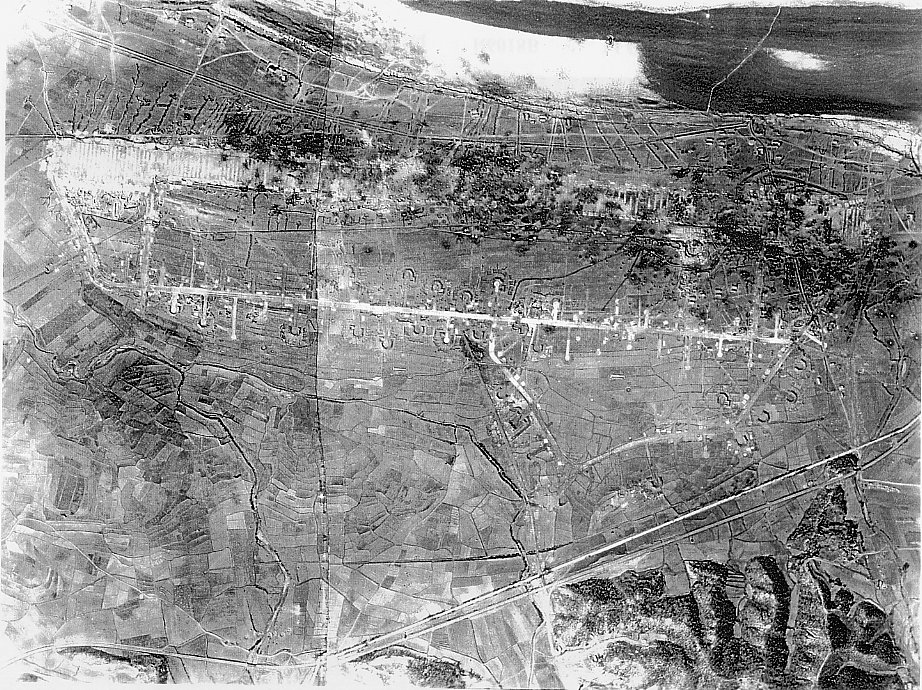
Photo 3
VV3-4 15th Tac Recon Sq R6141B 18 Oct 51
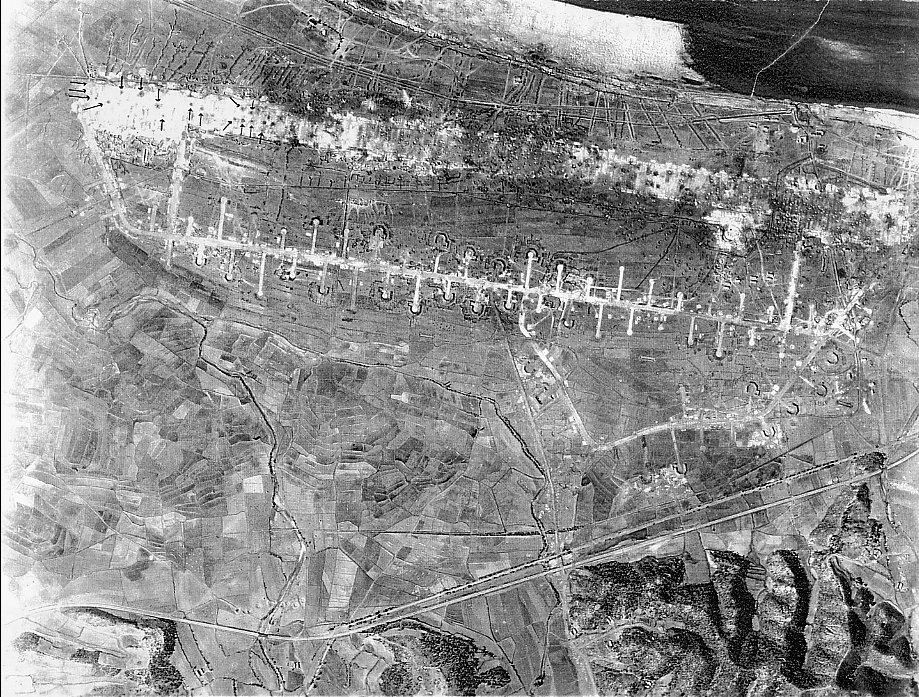
Photo 4
VV2 15th Tac Recon Sq R6173B 21 Oct 51
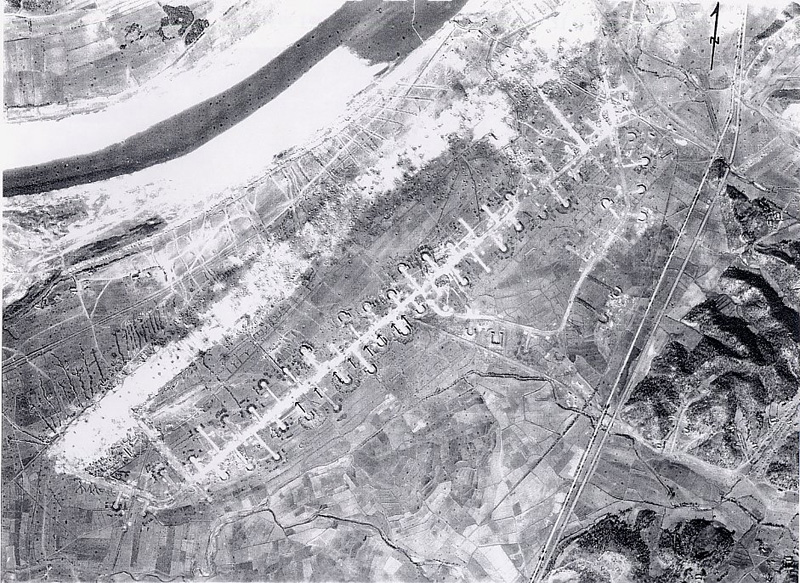
Photo 5
VV40 15th Tac Recon Sq R6186 22 Oct 51
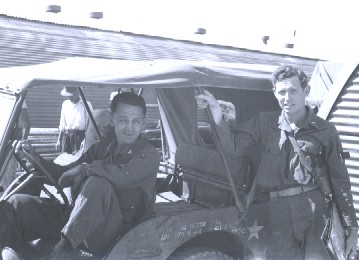
L to R: 1Lt. Howell Broxton and 1Lt. Dennis "Tex" Hill
"WELL, I STOLE
ONE TODAY"
by
Ruffin W. Gray
Colonel, USAF (Ret)
Commander, 15th TRS -- Oct. ‘51 - May ‘52

Just a quick addendum
to the Tex Hill Story. This mission was a front-line mission and
not considered more than a piece of cake. For some reason, I had
been scheduled to fly it and was just getting ready to hit the start
switch when the operations duty officer came running out to the
plane and stopped me telling me that I had been grounded by the
wing. I had knowledge of some classified missions coming up and
would be grounded until they had been flown. Tex came out and I
gave him my maps and mission data and he took off.
At low altitude, a slug
of approximately .50 cal came through the cockpit floor and went
into Tex's foot (in the instep) and came out the top side of his
foot, taking most of the top of the foot with it. When Tex landed
and got the plane stopped, I was in a jeep at the end of the runway
and jumped up on the wing. Tex was almost passed out from loss of
blood, and the cockpit was a mess. He was pale as a ghost and slumped
down in the seat but looked up with a forced grin and said: "Well,
I stole one today" - which was our expression at that time
for an easy mission.
Tex spent a long time
in the hospital in Nagoya where they did numerous operations on
his foot. He did not come back to the squadron. He loved Scotch
and had a seemingly unending supply in the hospital hidden in strategic
locations. The hospital finally figured out that it must be coming
in with the steady stream of guys from the squadron who always visited
him on R & R. A nurse and I almost went to the mat one day when
I had a bottle in each pocket of my overcoat and she insisted that
I would be searched before allowed to see Tex. It soon got down
to rank and position - and Tex got two more bottles.
Last I saw him, he was
at Hamilton AFB, CA flying F-104s. He walked with a limp but did
get back on flying status finally.
Letter:
2Lt. Norman E. Duquette
Kimpo Airfield, Republic of Korea
13 Oct 51

Hi --
Today is Saturday. The
weather is kind of stinko today so I might not fly. Probably get
up this afternoon. I thought I would try my hand at long hand writing
for a change. It seems peculiar to write this way as I haven't done
so in quite some time. I was wondering whether I still could or
not.
I sent Jay & Daddy
a birthday card while in Japan. The clothes you got for me arrived
yesterday. Thank you. They will be greatly appreciated this winter.
It takes about eight days for a package from the states. I was going
to do some Christmas shopping while in Japan but couldn't find any
likely presents so will leave the shopping up to you. I should get
another R&R before Christmas so will try to pick up a few things
then. I want to get you a set of pearls but the duty on them is
so high that I think that I'll wait & take them back with me...
...Just
got informed that Miller and I have got a Sinuiju mission this afternoon.
That's a rough one. Sinuiju & Antung are two "MiG" fields
up across the Yalu River. We have to take pictures of both fields.
We'll have a dozen or so F-86 Sabre Jets for escort.
Well I've got a lot
of briefing & preparation to make so will say so long for now.
Wish me luck. I love you and miss you very much. Tell Jay and Jan
hello and give them a smooch for me. Tell Jay to give you a smooch
for his Daddy.
Love, Duke
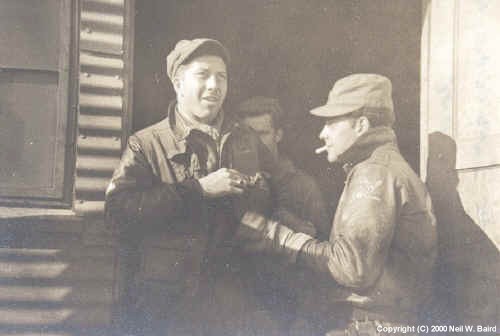
2nd Lt. Norman E. Duquette and 1st Lt. Neil Baird
15th TRS Operations, September 1951
TRANSCRIPT
Radio Interview
with 2nd Lt. Norman E. Duquette
Kimpo Air Base, Mid-October 1951
Reporter: We’re
located at the home of the 67th Tactical Reconnaissance Wing, better
known in combat circles as the "Eyes of the Front". Lieutenant
Duquette, how long have you been flying combat with the 67th?
Duquette: I’ve
been with the 67th for about a month and a half. Prior to being
assigned to the 67th, I was stationed at Shaw Air Force Base in
South Carolina where I went through jet photo-reconnaissance training.
Reporter: So what did
you do back in Plattsburg, New York?
Duquette: I was a student at Champlain College in Plattsburg. I
took two years in Champlain College. Prior to going to Champlain
College, I put three and a half years in the Navy during the last
war.
Reporter: Well tell us
about your job here in Korea.
Duquette: My job here
is flying the RF-80; the photographic version of the Shooting Star.
I’m a photo-reconnaissance pilot. Our job here is taking photographic
and visual reconnaissance of enemy installations. Prior to going
on to a mission we receive briefings as to what our targets will
be. We often take targets of opportunity of anything we happen to
see of interest on the ground and report that information immediately
to JOC [Joint Operations Center] Headquarters here at the field.
Reporter: Have you had
any unusual experiences since you’ve been flying combat?
Duquette:
Well, the enemy is very unpredictable. Yesterday afternoon I was up
north of Sinanju, up in what is known as "MiG Alley". I
was up there approximately one hour taking photographs of airfields
in that vicinity. We received no enemy contact, but about a half-hour
after I left the area, one of our boys was up there and the area was
loaded down with MiGs.
This morning, on a routine
mission about a half-hour ago, just north of the bomb line, was--there
wasn’t supposed to have been any flak—I received heavy
flak on all three of my photographic runs and was forced to abort
the mission.
Reporter: Well thank-you
very much Lieutenant Norman E. Duquette of 6 Lafayette Street in
Plattsburg, New York. This is the 5th Air Force and combat reporter
speaking from an advanced air base in Korea. And now back to station
WIRY in Plattsburg, New York.
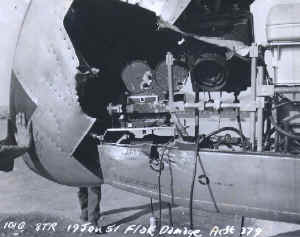
RF-80A Flak Damage 8TRS K-2 1951
"RF-80a
flak damage as noted. Believe Roy Hudspeth was the pilot. This was
a special mission with movie camera. Project was terminated shortly
after" -- Ed Stoltz
(USAF Photograph)
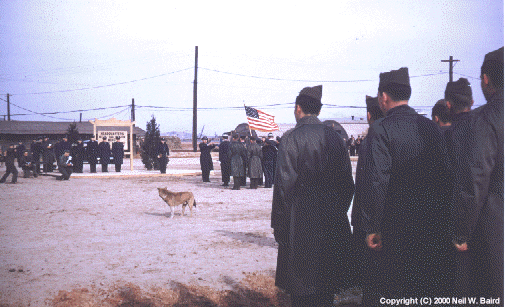
67th Recon Group
Wins Citation
For ‘Extraordinary Heroism
(Pacific Stars and Stripes, 1951)
FIFTH AIR FORCE—The
Fifth Air Force’s 67th Tactical Reconnaissance Group was cited
for ‘extraordinary heroism in action against an armed enemy’
in a recent ceremony at this forward UN airbase in Korea.
The thin blur streamer,
emblematic of the Distinguished Unit Citation, was tied to the 67th
Group’s banner by Lt. Gen. Frank F. Everest, Fifth Air Force
Commander.
The Group,
commanded by Col. Charles C. Andrews of Grenada, Miss., was cited
for the period Jan. 25 to April 21, 1951.
Reconnaissance pilots,
though they do not often make headline news, have a hand in nearly
every sortie flown by Far East Air Forces aircraft.
Unarmed RF-80 photo jets
of the 67th have provided the forces with the majority of all daylight
aerial photography of the war. Ranging as far north as the Yalu
River, they bring back photos of Communist airfields, road and rail
lines, marshalling yards and other military installations. Evaluation
of these photos gives data necessary to plan effective airstrikes
by other FEAF units.
It was an RF-80 of the
67th that discovered the three new Red airfields at Namsi, Taechon
and Saamcham. Another RF-80 pilot had a hard time keeping his mind
on his flying as he photographed the first enemy jets observed bases
in Korea at Uiju.
Bright and early on mornings
after B-29 raids, RF-80s show up over these bases to make photos
for bomb damage assessment. They manage to keep all of North Korea
under constant surveillance despite heavy and determined opposition
by enemy fighters and flak.
Night photo RB-26 aircraft
of the 67th the familiar B-26 painted black with armament replaced
by cameras do much the same job by night, dropping 800,000,000 candlepower
flash bombs for illumination.
They pay special attention
to night moving vehicle convoys. With the rail system beginning
to creak and groan under daily aerial interdiction attack, the enemy
has been forced to move supplies in trucks at night. More than 4000
trucks have been sighted during one night by this unit. As many
as 29,000 have been reported during one month. The location, speed,
and direction of movement of these vehicles are radioed to night
intruder planes of the 3d and 452d Bomb Wings for attack.
RF-51 Mustangs, as hunters
with Fifth Air Force’s current hunter-killer teams, operate
along and just behind the battle lines, supply points and gun positions
and putting the finger on them for destruction by fighter-bombers.
In all, the 67th has
flown more than 118,000 sorties since its elements first saw action
early in July 1950.
Aerial photo
labs of the 67th have turned out more than six million finished photos
of North Korea.
Part of the citation
reads: "The record of this organization shows repeated acts
of heroism, gallantry and personal courage. The impressive total
of combat sorties indicates high technical skill of maintenance
and ground personnel. Operating under adverse conditions on a continuous
daily schedule, the officers and airmen of the 67th Tactical Reconnaissance
Group reflected great credit upon their organization, the Far East
Air Forces and the United States Air Force."
At the time of the citation,
the group was commanded by Col. Jacob W. Dixon of Lexington, Mo.
After the
brief ceremony General Everest commented, "I know of no other
unit which more richly deserves the Distinguished Unit Citation than
the 67th Tactical Reconnaissance Group."
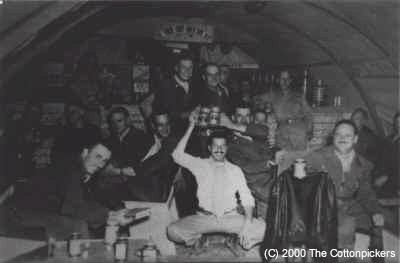
The Cottonpickers Club
Kimpo 1951
LET'S PLAY BOTTLES
by
Norman E. Duquette
Lieutenant Colonel, USAF (Ret)
The game referred to
as "bottles" is actually the first step in a long drawn
out game starting with, "bottles", then "caps",
and then "labels". It goes something like this:
A large group of half-crocked
fighter pilots, 10 to 20 or so, will start by someone suggesting,
"Let's play Bottles". The objective here is to start counting
with each member around the group responding to the next number
in line, and when a number is reached with the numeral "five"
or a multiple of "five", the individual who would supposedly
be responding with the number "five" or multiple thereof,
would instead respond by saying "bottles", i.e. counting
off as so: one, two, three, four, "bottles", six, seven,
eight, nine, "bottles", etc., etc.
This, of course, is
all done with a beer in hand by all. If you screw up and do not
respond properly on your turn, then you must pay the penalty of
"chug-a-lugging" your beer. Sounds easy. Yeah. Get warmed
up with a few circuits of "bottles", then you do the "bottles"
and "caps", with "fives" and multiples of fives,
plus "threes" and multiples of "threes", i.e.
One, two, "caps", four, "bottles", "caps",
seven, eight, "caps", "bottles", eleven, "caps",
thirteen, fourteen, "bottlers-caps", sixteen, seventeen,
"caps", nineteen, "bottles", "caps",
etc., etc.
THEN--about this time
everyone has erred at least once and bellies are getting more filled
with beer and you go into the "bottles", "caps",
and "labels" routine, with threes and multiples of threes,
fours and multiples of fours, and fives and multiples of fives.
That's the REAL test. Try it sometime and see how "ga-ga"
folks get trying to remember or think what they are supposed to
say.
A BIRD IN THE HAND
by Neil Baird
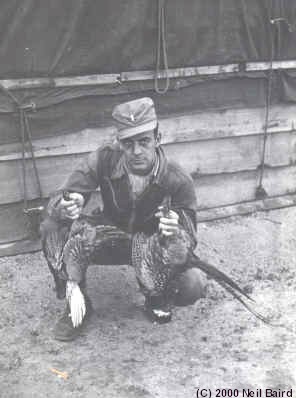
John Pell and I were
avid hunters. We had heard that there was a good population of pheasant
in the surrounding areas of Kimpo. It being winter and some bad
weather days that we couldn't fly, we decided to try our hand at
changing our diet. The only guns available to us were 30 cal. carbines.
Now you know it's pretty tough to hit a pheasant on the wing with
a rifle. Keep in mind that we had pretty deep snow so birds did
not run on the ground but flushed. John and I had some success,
but missed a lot more than we hit after miles of walking.
We heard that the PX
in Nagoya, Japan had shot guns - so - off we went on R & R to
Nagoya; only to find out they were sold out. They did steer us to
a Marine PX back in the "Tulles" that had shot guns. Off
we went by electric train about an hours ride - then a 4-5 miles
walk to this base. Well, we got our shot guns and some shells and
made our way back to Kimpo.
Things took a turn for
the better in bagging pheasants and we were eating high on the hog.
John got an in with the mess Sgt. and we had a nice table with dishes,
etc when we were called to dine while the rest of the officers ate
from steel trays.
Needless to say, this
came to the attention of some of the brass when they saw two 1st
Lts. eating (dining) pheasant at a well-set table. John and I were
called to Group HQ to see the group commander (Col. Chickering)
to explain how we managed to eat so well. We explained to Col. Chickering
that we walked for miles (we did too) in deep snow and cold to get
these birds; sometimes as far as 3-4 miles from base. We were asked
why we didn't share our game (based on complaints from other officers).
I told Col. Chickering we had offered ANYBODY a share if they would
go help us kick birds up, but we had only one taker who was so tired
after he got back to base he refused to get out of the sack to eat.
Col. Chickering
had a jeep with an enclosed metal cab and a heater. He offered John
and I the use of his jeep to get us to areas we hadn't hunted. We
jumped at the offer. From that time forward, we went in style to far
reaches around Kimpo and when John and I returned to base, we took
the pheasants to the mess Sgt. That evening John and I dined on pheasant
and Col. Chickering and his guests also had a nice pheasant dinner.
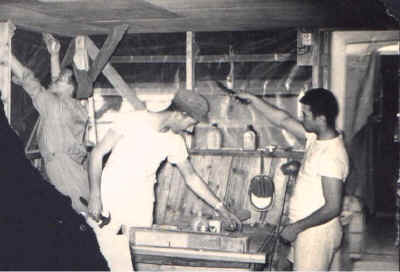
The beginning of the
Waldorf Astoria
(L to R: Lts. John Pell, Norman Duquette, Paul Marco)
Letter:
2Lt. Norman E. Duquette
Kimpo Airfield, Republic of Korea
17 Oct 51

Hi--
Received three long
lost letters from you yesterday. They were written between 15 Aug
& 1 Sept. I just got back from my 22 mission. Coming right along.
That's 22 missions in 37 days. Discount five days R&R &
it makes 22 out [of] 32. So between 4 1/2 & 5 months from 10
Sept you should see me trotting into the backyard. That should make
it around February. Maybe for your birthday. O.K.?
We had to move to another
part of the field yesterday. Just when we had our tent in a livable
condition. That means building new tables & chairs & a wash
stand to hold steel helmet. It means erecting another stove &
interior decorating in general. We've been busy at it since moving
& are coming along nicely. Carpenter equipment is a scarce item
so things progress slowly & primitively with whatever we can
devise to accomplish the job. Got a lot to do yet before cold weather
sets in. I'm going to get busy again & see if I can build a
clothes rack. My clothes are all stuffed in a bag in [the] corner.
Just thought I'd let
you [know] I made out all right on the trip to the Yalu River the
other day. So long for now.
Love you.
Duke
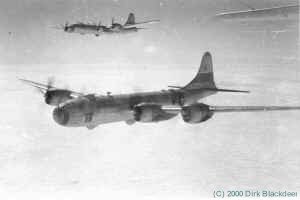
B-29s en route to target over North Korea
(Major Dirk Blackdeer Collection)
BLACK TUESDAY
by
Norman E. Duquette
Lieutenant Colonel, USAF (Ret)

In the late summer and
early fall of 1951, most daylight air reconnaissance missions into
North Korea were flown by lone RF-80 pilots, known affectionately
as "Photo Joes". They were all members of the 15th Tactical
Reconnaissance Squadron, 67th Tactical Reconnaissance Group, operating
out of Kimpo Air Base (K-14) in South Korea. Known as "The
Cottonpickers", the 15th was the only jet photo recon outfit
in the 5th Air Force. I was assigned to the Squadron as 2nd Lt.
in August 1951. I was fresh out of jet fighter training at Williams
Air Force Base, Arizona, and photo-reconnaissance operational training
at Shaw AFB, South Carolina. The squadron motto was "Alone,
Unarmed, and Unafraid" and above the bar in the squadron's
"Cottonpickers Club" tent was posted, in large and brazen
letters, the words, "Every Man A Tiger". I learned quickly
that these were more than boisterous slogans when air missions required
a trip to the Yalu through MiG Alley.
The 15th Squadron was
equipped with a modified version of Lockheed's F-80A "Shooting
Star" fighter aircraft. This single engine jet fighter had
its guns removed and was refitted with a "camera" nose
that mounted a variety of long range, long focal length, high and
low altitude cameras in the various camera bays. In this configuration,
it was re-designated the RF-80A. The RF-80As that we flew from Kimpo
were stripped down and faster than the normal F-80--but they were
old birds. Many had cracked main wing spars, and none of the aircraft
were equipped with the luxury of an ejection seat or canopy.
For photo-reconnaissance
missions, North Korea was divided into three sectors. From the 38th
parallel to an east/west line just south of Pyongyang, RF-80 pilots
flew alone and unescorted as we were somewhat safely out of the
range of MiGs based in China. North of Pyongyang to a line running
east to west through Sinanju, RF-80s flew in pairs as this was well
within MiG range. One pilot conducted the photo-reconnaissance mission
and the other scanned the skies for MiGs. North of Sinanju to the
Yalu River, in an area known later as "MiG Alley", reconnaissance
aircraft were escorted by F-86, F-84, and/or Meteor fighters of
Royal Australian Air Force (RAAF) 77th Squadron. More often than
not, the Kimpo based F-86s of 4th Fighter Wing and the Aussie 77th
Squadron provided our escorts. There were times on the F-86 escort
missions that I felt I was being used as bait for a "fishing
expedition". Fighter jocks being what they are, and with a
primary mission in life of shooting down MiGs, they did not take
kindly to being hamstrung by a gun-less, "Photo Joe",
RF-80 type.
We flew many missions
to photograph the enemy's MiG bases. At times, the targets would
be the North Korean airfields at Namsi, Taechon, Sinuiji, or Kunari.
Other times the targets were Antung and Ta Tung Kao just north of
the Yalu River on the Chinese side. When flying an airfield recce
mission, I would break from my fighter escort just south of the
target. After a rapid descent, I would point the nose of the airplane
directly at the target, and begin my photo run. The RF-80 had long
distance, 40-inch focal length oblique nose cameras that pointed
straight forward and took large 9 by 18-inch negatives. As I approached
close in to the target, the entire airfield or target would fill
the camera lens. The photographs taken would reveal valuable intelligence
for future UN Air Forces mission planning. Our escorts would continue
to cover us until we completed our photo runs and then we would
turn south and skeedaddle for home. We flew out as fast as our RF-80s
could scoot until we got out of MiG range--on the deck or as close
as we could get to the waters of the Yellow Sea.
As it was
in the best interest of reconnaissance pilots to establish good relations
with the Fighter Jocks, 15th Squadron pilots hosted many parties at
the "Cottonpickers" Club. It soon became a favorite meeting
place for the boys from the Kimpo-based 4th Fighter Wing and the Aussie
77th Squadron. Many of my classmates from "Willie Field"
were in the 4th Fighter Wing and flying the F-86s. This included such
folks as future astronaut "Gus" Grissom and future Ace,
Jim Kasler. They were the guys that kept the MiGs off our backs and
many tall tales of the "Hairy" missions of the day were
discussed over the "Cottonpickers" plywood bar. On one such
occasion, a flight of four RAAF Meteors chased and shot down a MiG
that was in hot pursuit of a 15th Squadron RF-80 they were escorting.
All four Aussie pilots in the flight got confirmed hits on the MiG,
and each was credited with a quarter of a MiG kill. This gave cause
for great mutual celebrations at the "Cottonpickers" Club
that evening. The Aussies were great dart throwers and when bad flying
weather curtailed flight operations for the next day, great games
of darts ensued. Arm wrestling and drinking games were played and
foul Fighter Pilot drinking songs were sung late into the night. Those
were great times to remember.
Temperatures started
to fall the in first couple of weeks of October 1951 and winter
flying gear was issued to pilots as needed or desired. Enemy air
activity increased dramatically and MiG encounters and 15th Squadron
losses began to mount. On 2 October 1951, MiGs shot down 1st Lt.
Bruce Sweney, while he was on a mission just south of the Yalu River
over the Namsi-Taechon area. His RF-80 was hit at about twenty thousand
feet and exploded. A parachute was observed to deploy by the pilots
in his F-84 fighter escort. He landed in a rice paddy but was never
seen again.
In early October 1951,
1st Lt. Tex Hill of the 15th Squadron was on a lone reconnaissance
mission perusing the area between Sinanju and the Yalu River. Here
he detected two previously unidentified North Korean Airfields under
construction. Tex took many photo-reconnaissance pictures, the photos
were interpreted and the resulting intelligence was forwarded to
the appropriate Headquarters. The Namsi and Taechon Airfields had
been discovered and were now added to the "Hit List" for
attacks by our bombers and fighter-bombers. They also became constant
reconnaissance targets for 15th Squadron surveillance.
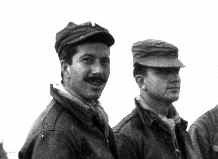
Lieutenants Duquette and Powell
(Norman E. Duquette Collection)
Early on the morning
of 23 October 1951, 1st Lt. Ray Powell and I attended the thorough,
well-organized, 67th Tactical Reconnaissance Group briefing for
all the Group pilots. The briefing covered theatre air activity
for the previous day's combat operations and included aircraft and
personnel casualties for the Army, Navy, and Marines. Then came
a rendition of proposed operations for the day. Group Operations,
Air Forces Command Headquarters had laid on a B-29 bombing raid
against the Namsi and Taechon Airfields for mid-morning. Weather
reports indicated a great day for flying. Lots of blue sky that
would provide ample warning of enemy aircraft presence in the air.
Clear skies always provided some protection and comfort in the knowledge
that the telltale MiG contrails would again be visible from many
miles away. Looking initially like silver dots on the horizon, the
MiGs would rise up into the skies above their airfields in China.
Those silver dots and ensuing contrails could be seen for some distance
as they began forming their large combat formations just north of
the Yalu. After a few minutes, they would head south across the
river to meet with the contrails of our northbound aircraft. Then
the daily dizzying swirl of air combat in MiG Alley would begin
again.
On returning to the 15th
Squadron Operations hut, Ray and I learned that one of the tasks
for the RF-80's that day was to send two "Photo Joes"
to tag onto the B-29 Bomber stream coming out of Okinawa to bomb
the Namsi and Taechon Airfields. The B-29s would be escorted by
34 F-86 Sabre Jets in a high escort position to fight off the MiGs
attacking from above. In addition, 55 F-84s and Meteors would fly
escort at bomber altitude to fight off any MiGs that broke though
the Sabres. Ray Powell and I, the elected "Photo Joes",
were instructed to follow about fifteen minutes behind the Bomber
stream and, after the "bombs-away", take Bomb Damage Assessment
photographs of the two airfields.
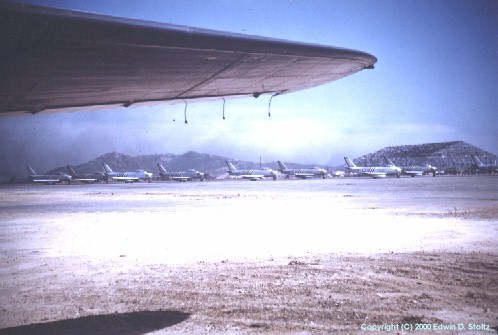
At the appointed time,
Kimpo came alive with the whine of jet turbines as the three squadrons
of 4th Fighter Wing and the RAAF 77th Squadron jockeyed for take
off. With the launch of the fighters complete, we manned our RF-80s
and were soon airborne en route to our targets. As we followed,
the strike mission, we listened in to the radio chatter of the bombers
and fighters as they talked between themselves and with Ground Control.
When we neared the Chinnampo Peninsula, we could hear our Radar
Control, "Stovepipe Control" calling out the departure
of MiG aircraft from their bases across the Yalu. "Train number
one leaving the station"; "Train number two leaving the
station". Each "Train" indicated a flight of an unknown
number of MiGs. By the time the bomber stream reached Namsi, Stovepipe
Control was calling off, "Train number twelve leaving the station",
which meant that the air would soon be full of MiGs. Squinting to
the northern skies, we could see a myriad of silver dots and masses
of contrails in combat formations as 130 MiGs made a gradual, massive
swooping turn to the South.
The MiGs came in much,
much higher in the sky than our F-86s could reach, upwards of 55,000
feet, and the MiGs barreled right through the F-86s, Meteors, and
F-84s. They yo-yoed up and down, to and from high altitudes to rain
havoc onto the bombers. With over two hundred aircraft swirling
about the skies, the largest single air battle of the Korean War
had just broken out over MiG Alley. The whole force, bombers and
fighters alike were catching hell from the MiG cannon fire and the
radio chatter intensified. B-29s were being shot down, crews bailing
out, and other badly damaged aircraft were limping for cover after
dropping their bombs onto the targets. One B-29 made it over the
Yellow Sea before it crashed in flames. Several shot-up aircraft
managed to make emergency landings at Kimpo Air Base and other airfields
in South Korea. The whole disastrous event took place in a matter
of minutes.
By the time Ray and
I reached the area of the Namsi and Taechon Airfields, the air space
had become suddenly, and very eerily, vacant of aircraft and radio
chatter. All friendly and enemy aircraft had disappeared as they
completed their bomb runs or ran low on fuel and returned to base.
We flew our RF-80s over the airfields for our Bomb Damage Assessment
photo runs. We would later learn from viewing our photographs, that
heavy enemy antiaircraft fire was being hurled at us as we passed
over the airfields. The photos revealed many gun muzzle flashes
from the air defense weapons positioned around the perimeter of
the airfields. We returned safely to Kimpo in a sky that had grown
deathly quiet. We were unscathed by all of the days action, except
the feelings of grief for our fallen comrades. The next day, the
B-29s would have a similar encounter in MiG Alley. Unwilling to
endure the losses suffered in these two days of battle, Bomber Command
ended daylight bombing missions over North Korea. Bomber pilots
would later refer to 23 October 1951 as "Black Tuesday".
Flying missions at night
was not an option for the 15th Squadron. Many more photo missions
would be flown through MiG Alley to the Namsi and Taechon Airfields
to maintain reconnaissance surveillance of airfield repair and airplane
activities. My last mission to the Namsi and Taechon area was in
early January 1952 and was escorted by 4th Fighter Wing Ace and
Medal of Honor winner Lt. Col. George Davis. He was shot down and
killed on 14 February 1952.
As I flew that last
mission over the Namsi and Taechon, little did I realize that in
several weeks hence, I would be sitting in solitary confinement
in North Korea with a fractured back, head wounds and under interrogation
as a Prisoner of War. On 26 January 1952, I was on a solo reconnaissance
mission en route to photograph an enemy airfield south of the Chosen
Reservoir, when I was shot down over Hamhung by antiaircraft fire.
I would spend the next year and a half as a POW of the North Koreans
and Chinese.
Despite my captivity
in a POW camp on the Yalu River, the air battles over MiG Alley
continued to be part of my daily life. From the ground, I watched
the same contrails I had observed so many times from the air as
they approached from both the north and south in preparation for
doing battle directly overhead. Because of the distance, the sights
and sounds of the smoking aircraft guns would be separated in time.
I could see the fighting and firing but could not hear the noise
of the firing until some seconds later. The F-86's .50 caliber machine
guns would "chatter" and the MiG's cannon's would "garumph"
as the aircraft tangled from contrail altitudes to ground level.
The time it took for the "chatter" and "garumph"
noises to reach the ground made it difficult to tell just who was
chasing whom or who was doing the firing or who was getting shot
at or hit. The MiGs and F-86s were so similar in looks that when
a swept-wing fighter went down burning, smoking, and crashing into
the ground, you couldn't tell whether it was a MiG or an F-86. The
fact that we could see that the fighting was still underway was
enough to give hope to the helpless, sick and wounded POWs that
someday, The War would be over and help would be on the way.
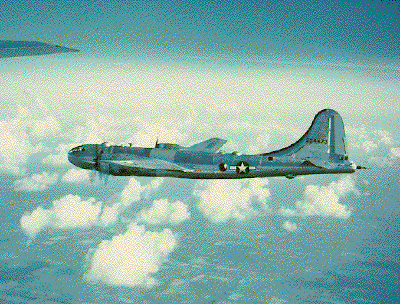
Letter:
2Lt. Norman E. Duquette
Kimpo Airfield, Republic of Korea
24 Oct 51

Dearest Louise Jay &
Jan --
Yesterday & today
saw two of the fiercest air battles of the war. I was in on the
one yesterday, the 23rd of Oct. You'll have heard about it by the
time you get this letter. I got back without a scratch. Some didn't
get back and some were pretty well scratched when they did get back.
I got my first lieutenancy
yesterday and it was dated the 20th of Oct. A birthday present for
Jay. Also got my first air medal last week. I think that I'm up
for the Distinguished Flying Cross also. I flew my 28th mission
yesterday. When I got back I found that I was to be sent to Taegu
to school for a couple of days. I flew down in the afternoon. I
am supposed to go back to Kimpo loaded with information & education
on defense against chemical, biological & radiological warfare,
plus winter survival technique, and how to requisition winter clothing
for my squadron. This information I am supposed to divulge to the
squadron in a series of lectures. It's very interesting and makes
a change from the regular routine.
We have our new tent
just about remodeled now & it's the envy of the whole squadron.
We've put a lot of work into it. I'll have some pictures made &
send them. It's very elaborate under the circumstances.
I ran into five of my
classmates down here. I saw Shepherd, Parker, Moore, Tanksley &
Tiernan. Miller & I are the first men in 51-B to make 1st Lt.
So photo recon isn't such a bad deal after all. The boys in fighters
shudder when we tell them of our exploits over the lines in our
alone unarmed F-80.
I'm enclosing
a clipping of what my squadron does. Gotta get some sleep now. Goodnight.
Love you.
Duke
NO BOMB CRATERS
- NOT ONE
by
Ernest R. Harden, III
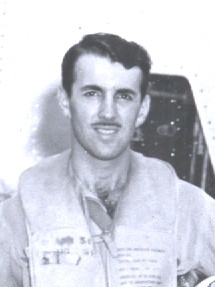
The log sheet in my flight
records for the period October 1951 (certified by 1st Lieutenant
James M. Nimmo) shows one combat mission on 14 Oct 51, duration
1.20, "NK. rr K-14" (North Korea round robin Kimpo). Unfortunately,
that October 51 log sheet shows I flew 28 missions that month NK
rr K-14. Targets are not identified. I did take a number of pictures
in the area between Sinanju and Sinuiju (including Namsi, Saamcham
and Taechon) starting in late September, but I cannot correlate
missions with targets and dates...with one exception. That was a
mission on 23 October 51 to cover one airfield in MiG Alley. I think
it was Namsi.
I remember that mission
for a couple of reasons. Earlier in the day, three shot up B-29s
limped into Kimpo. I was provided an F-86 escort and had to go across
the field for pre mission coordination with the escort leader, Colonel
Francis S. Gabreski, about whom I'd heard a lot but had never met.
There were a couple of B-29 flight crew members there (one still
in a bloody flight suit, as I recall).
The mission required
me to be airborne about 20 minutes ahead of the 86s to make our
rendezvous point near Chinnampo on time. That meant I needed to
hustle, which I did... and nearly blew it in the process. I taxied
over a piece of loose PSP in our parking ramp, causing the steel
plank to curve up and gash my left tip tank (under slung variety)
and dump out all the fuel in that tank. There I sat, with my left
wing pointing at the afternoon sun and my right tip tank drooping
in the mud. I jumped out of my aircraft and ran over to a nearby
pilot getting ready to go on another mission. He saw my plight and
let me take his plane. I don't remember who the guy was; I hope
I said thanks. Anyway I finally got airborne and arrived at the
rendezvous point just barely ahead of the 86s.
We headed north and shortly
thereafter, somewhere a bit northeast of Sinanju, saw them coming
head on--a whole gaggle of MiG-15s line abreast. I watched in total
fascination as they (or was it the F-86s ?) toggled off their drop
tanks. They tumbled ever so slowly, it seemed, and for a moment
I thought I might hit one. That was the last I saw of the MiGs and
the F-86s that day. They had their own ball and apparently I was
not invited. I moseyed on to my target without any further distraction
except for a few bursts of 85mm anti-aircraft artillery fire, got
my brownie snaps, did a split S to expedite my departure for friendlier
airspace at a lower flight level and headed home.
That night
I visited our recce tech's PI section to see my pictures. They were
pretty good except for one thing. There were NO bomb craters -- not
one. Those poor guys in the B-29s never got to their target that day.
Those pictures obviously were not used in planning the 23 October
raid. They could have been used for a later raid. The B-29s eventually
did get to Namsi and were able to do their job AT NIGHT.
KOREA
15th Tactical Reconnaissance Squadron, Kimpo.
(an extract, "From Kid to Captain" by James R. Hanson)

"October
30th. I had the right kind of escort today. The mission called for
a photo run down the Yalu river to cover three airfields, two on the
Korean side of the river, and an oblique of Antung, which is just
across the river in Manchuria. There's no way to do this without getting
into a hassle with the MiGs. So I was assigned an escort of eight
F-86's from the 4th Fighter Group, and the rest of the Group would
be in the area for their regular MiG fest. They were eager to do it
because they were sure of a fight. As we near the target area, radar
starts calling out "trains" leaving the station ( MiGs taking
off). They are all climbing and staying north of the Yalu River. I
start my run to the southwest down the river with the F-86 escort
to my left, on the Korean side, because American planes are not "permitted"
to cross the border into Chinese territory. I complete the photo run
on the first airfield when the escort leader calls out ten MiGs, line
abreast, starting a run at us. They call for me to break left and
under them but I call for them to break over top of me and into the
MiGs as I want to get the next airfield just ahead. There is no time
to have a discussion, and when they see that I?m not changing course
they break over top of me and meet the MiGs head on in their own territory.
The MiG leader hadn't counted on that and they break off their attack
and turn back north. I have to break off the run on the third airfield
halfway through because I'm in the middle of a real dogfight between
the 86's and MiGs. I get great cover and most of the job done so it
is a "good show" all around.
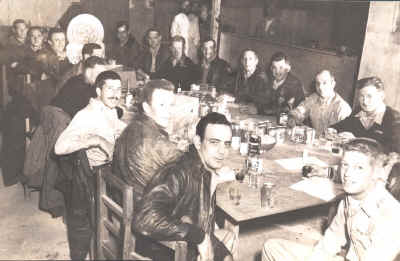
The Cottonpickers' Halloween
Party, Kimpo, 1951
Letter:
2Lt. Norman E. Duquette
Kimpo Airfield, Republic of Korea
31 Oct 51

Happy Halloween --
Got a letter from you
today with snap shots in it. Glad to hear that you got a copy of
the recording they made. I got my 34th mission yesterday. Didn't
fly today because of bad weather & the fact that I had to dole
out many thousands of dollars to the troops again today as payday
has rolled around again. I'll try to get over to the post office
in the near future & send you some of the money I've been saving.
I saved $150.00 last month after paying for two months of chow &
loaning Miller $52.00. I got paid $80.00 this month & have about
$30.00 coming for travel pay. I'll send you a check for what Miller
owes me plus $160.00 in money order. I'll check up on other allotment
check. Rumor has it that we're supposed to get a 10% increase in
pay January 1st retroactive to July 1st of '51. That will give us
about $300.00. Nice nest egg. All of our bills will be paid to Uncle
Sam by then so we should really be able to save some money then.
Miller wants me to have
his clothes sent to his girl. Her address is.
Miss Ann Currie
ASC Mathews Hall
Tempe, Ariz.
We have a Halloween get
together tonight at the chow hall. Supposed to have a seafood dinner
& lots of beer afterwards. These affairs always end up in drunken
song fests. I've taken on the additional duty of being club officer
for our squadron club. It's sort of fun. Although it takes a lot
of my spare time. I have to handle all the stock & finances
plus supervise the cleaning up of the place daily & scheduling
a bartender. We do about $1,000.00 a month business. The profit
is turned back into the club in the form of Records, books, free
snacks, general improvements and we've purchased a private beer
mug with names on them for every man.
If you
have an Esquire Magazine at home would you thumb through it &
see if you can [find] any knit wool golf caps. They're of the 1929
style & were very popular back in the states when I left. They
are very flashy colored. The style is that which was worn by the old
time dappers while driving an automobile. Picture.
If you find such an
ad would you please send it to me as we would like to purchase one
for each pilot. We'd like to get them with large orange & blue
checks. We now have orange silk scarves to set us apart from other
airplane drivers. But this would be the ultimate for differentiation.
Got to rush off to the
party. Goodnight. I love you.
Duke
|

